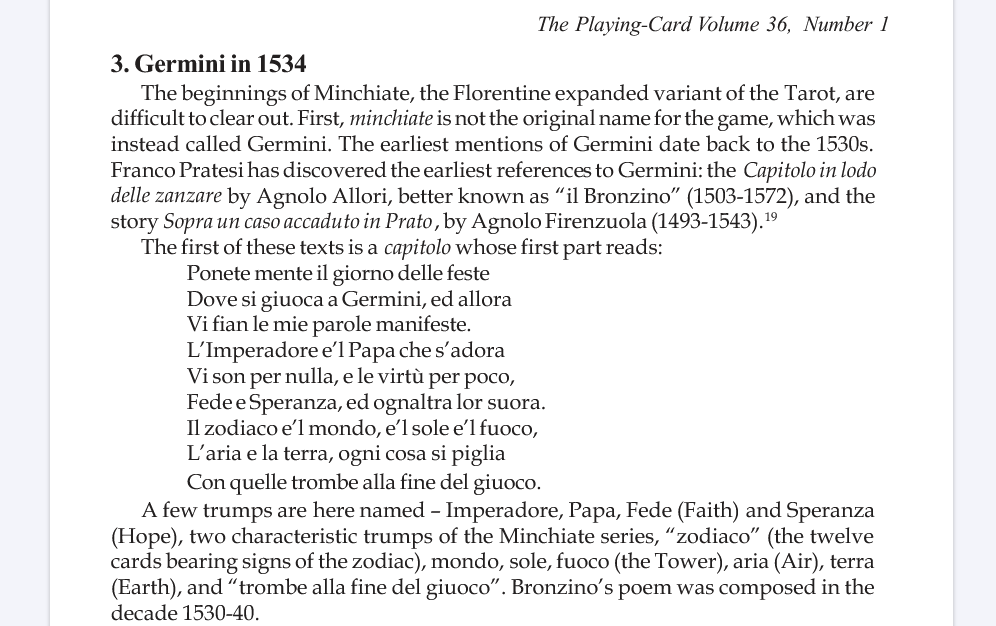I have one more thing to say about the switch from Croce's order to the standard Bolognese order in the 17th century. Croce, you will recall, for a party game in Bologna imagined an Emperor and Empress among the triumphs. The book was first published in 1602 and had another printing in 1620, suggesting that the same was true then.
That in the Emperor and Empress, as well as two others, a Pope and one other, probably the Popess, sometime in the second or third quarters of the century switched to all "papi" is suggested by a parallel situation in Florence with Minchiate. Here is Depaulis, "Early Italian Lists," 2013, online, p. 45 (and of course we know now that references to Germini in Florence go considerably earlier than 1530):
Here we have two of the three Minchiate dignitaries, Pope and Emperor. Nazario Renzoni, who wrotean earlier article on the Bronzini poem
(The Playing Card 41, no. 2, Oct.-Dec. 2012), observed that a later edition of the poem included the Empress (pp. 85-86):
It is interesting to know that in a later version of the poem the verse L'Imperadore e 'I Papa che s'adora is replaced by L'Imperatrice, e Valtre, che si onora.
So we have all three. But by sometime in the 17th century, these three - Imperadore, Papa, Imperatrice - became just "papi" 2, 3, and 4, with Love at 5. Renzoni concludes (p. 86):
It is perhaps worthy of note that these three cards, which together with the Ganellino and L'Amore were already known in the XVII century by the generic name of papi (popes), at Bronzini's time were still distinguished by their specific names.
Below, Depaulis's columns, from left to right are: Bologna, Minchiate, Rosenwald, Strambotto (Depaulis p. 43). Given what he said earlier about the Bronzini, these columns each apply to a different time: the Bologna is 1602 (Croce's time), the Minchiate is sometime in the 17th century, the Rosenwald is early 16th century, and the strambotto is c. 1500.

In Bologna they played Minchiate as well as tarocchi/tarocchini, as is known from the editions featuring the Bologna skyline on the Trombe card, hardly appropriate for Florence. I suspect that the reason Love is 5 in the Bolognese tarocchini is that it was 5 in Minchiate. It will be less confusing for those who play both games. So it seems reasonable to me that when Minchiate changed, the Bolognese tarocchi would have changed as well, although which would have come first is not yet settled. The difference, aside from the greater number of triumphs in minchiate, of course was that there were four such "papi" in the Bolognese tarocchi vs. three in minchiate. That would ordinarily have made Love number 6; but they got around that problem, when they started numbering the triumphs, by simply having those before Love be unnumbered. The two decks, tarocchini and minchiate, were numerically in sync.
This change of title is a separate issue from the "equal papi" rule. That rule applied or didn't apply regardless of the gender and type of crown the "papi" happened to be thought in terms of, as we know from Piscina and the type of deck that would have been used in Piedmont, with two males and two females. But changing from four names to calling the four all by the same name makes more sense if they all had equal power from the start. So, at least from this perspective, it is more likely that the practice started with the Bolognese 78 card deck, and then spread to Minchiate in Florence, than the reverse, as well as continuing in Bologna with the 62 card deck, whenever it was instituted.


